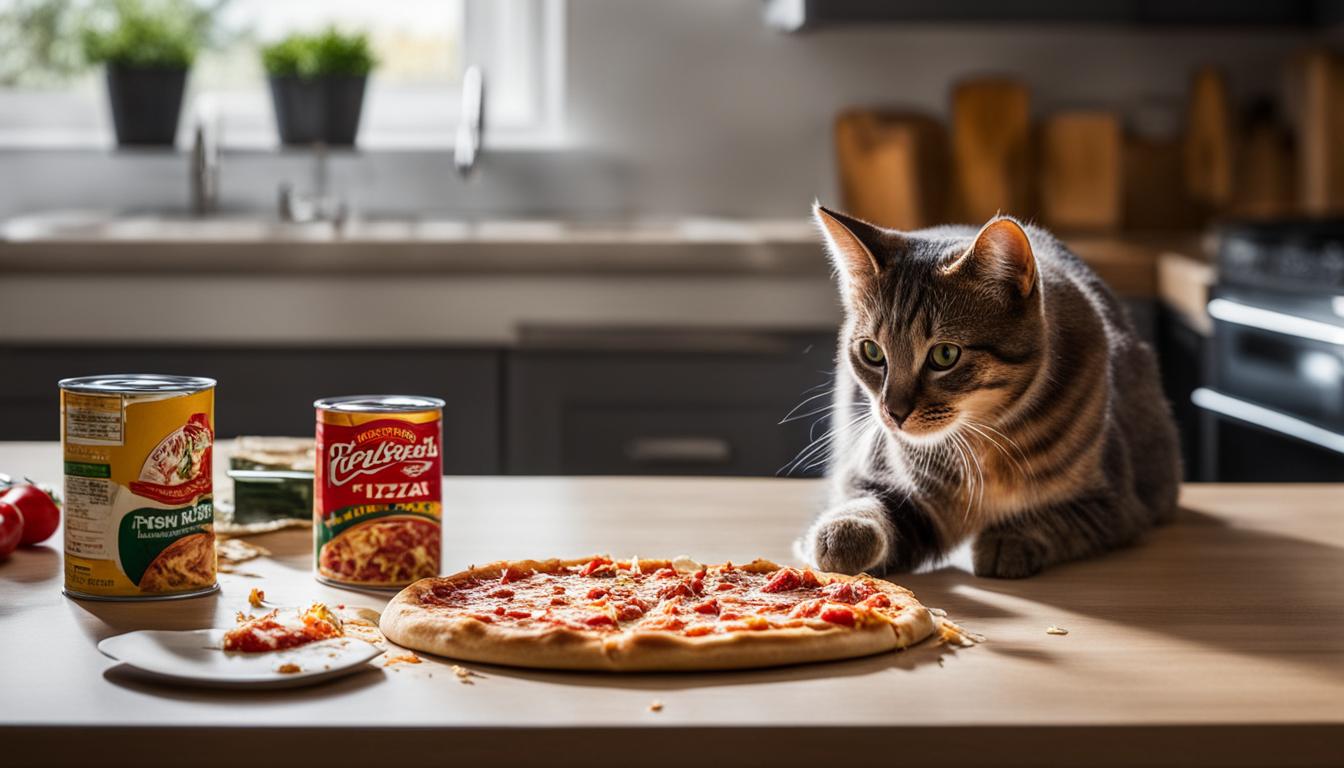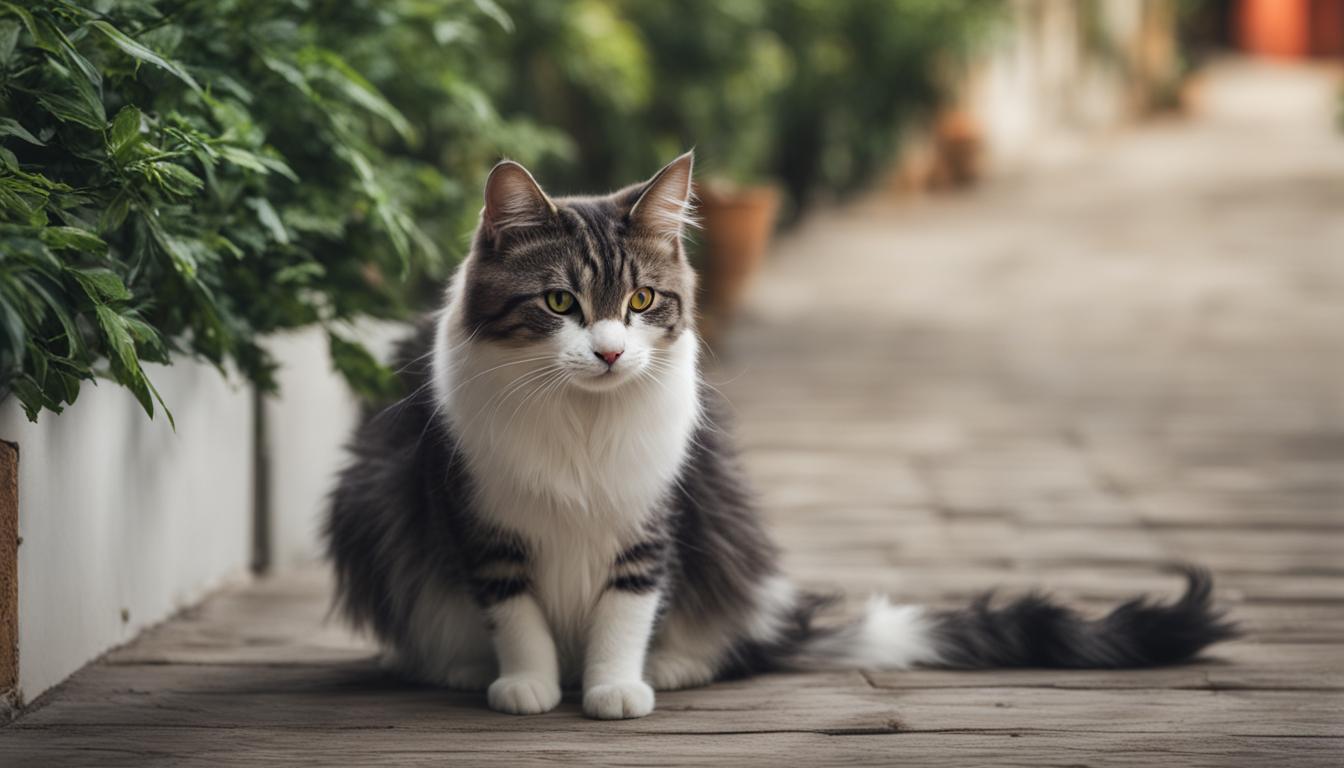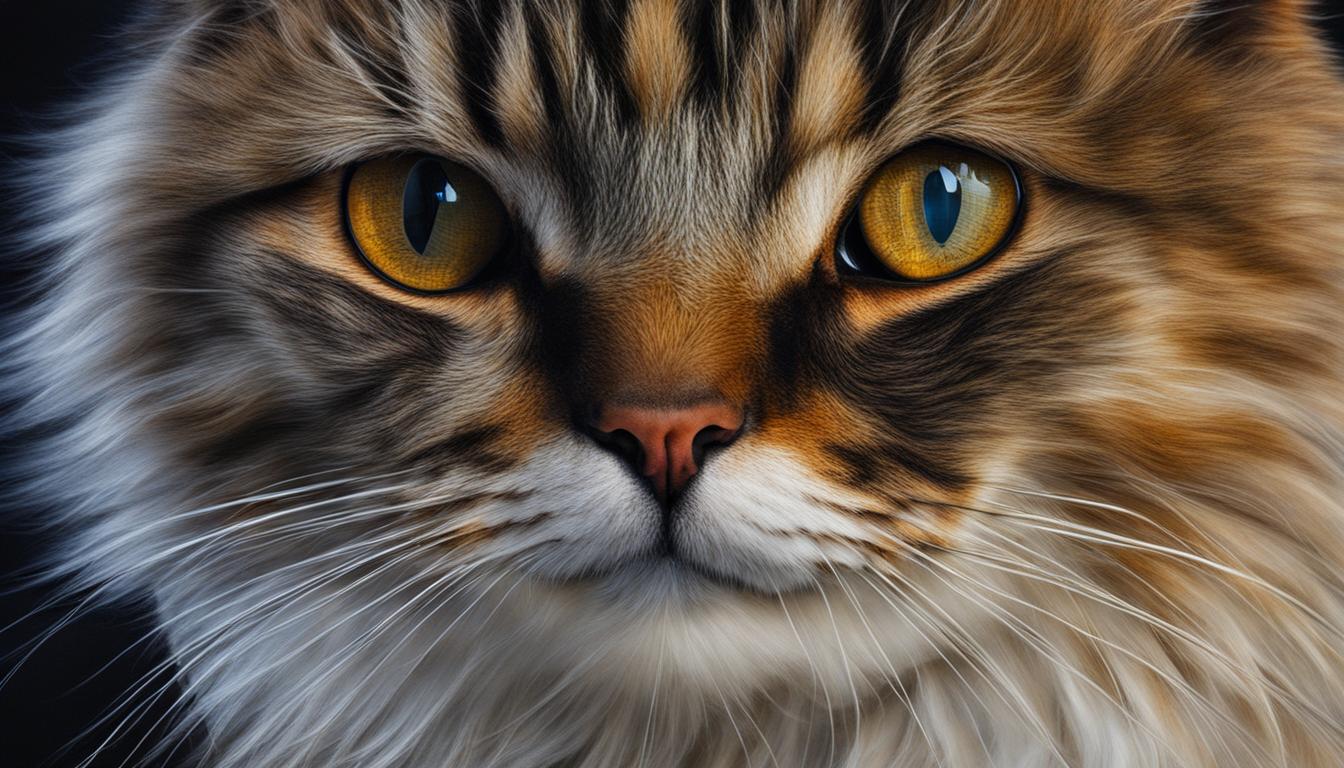Curiosity killed the cat, or so they say. But when it comes to cats and human food, curiosity is just part of their nature. As a cat owner, I’ve often wondered why my furry friend can’t resist trying to snatch a bite from my plate or investigate the tantalizing smells coming from the kitchen. So, I decided to dig deeper and understand the curious behaviors of cats when it comes to human food.
Key Takeaways:
- Cats’ curiosity about human food stems from their natural instinct as hunters.
- Some abandoned cats may have developed a preference for human food due to their survival instincts.
- Understanding cats’ taste preferences can help provide a balanced and enjoyable diet for them.
- Training cats to avoid human food is essential for their nutritional well-being.
- While some human foods are safe for cats in moderation, it’s crucial to avoid toxic foods.
Cats’ Curiosity and Taste Preferences
Cats’ curiosity about human food is a natural behavior rooted in their instinctual hunting nature. They are naturally inclined to explore different smells and tastes, and this extends to the food their human family consumes. You may have noticed your cat showing interest in certain foods when you’re eating, perhaps even trying to snatch a bite from your plate. This behavior is driven by their natural curiosity and desire to imitate their human parents.
But why are cats attracted to certain foods more than others? Well, cats have taste preferences, just like humans. They may find certain flavors more appealing or enjoyable than others. This preference for certain foods is influenced by a combination of factors, including their individual taste receptors and past experiences with specific flavors. It’s important to understand these preferences so you can provide a balanced and enjoyable diet for your furry friend.
While cats’ curiosity about human food is natural, it’s crucial to manage their access to it and ensure they receive a nutritionally balanced diet. Feeding them excessive amounts of human food can lead to nutritional imbalances and health issues. By understanding their taste preferences and providing them with a suitable cat food that meets their nutritional needs, you can satisfy their curiosity while keeping them healthy and happy.
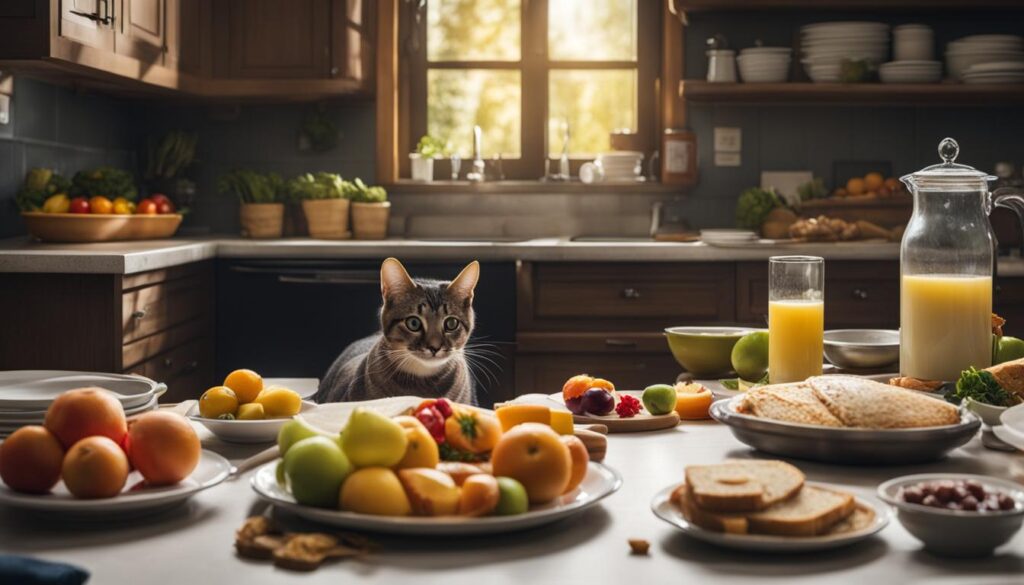
Table: Cats’ Taste Preferences
| Taste Preference | Examples of Foods |
|---|---|
| Savory | Cooked chicken, turkey |
| Fish | Plain cooked fish |
| Sweet | Fruits (in moderation) |
| Texture | Soft or crunchy foods |
While it’s important to prevent cats from eating excessive amounts of human food, there are safe options that can be given to them in moderation. However, it’s always recommended to consult with a veterinarian before introducing any new human foods into your cat’s diet, as some foods may be toxic to them. By understanding and managing your cat’s curiosity about human food, you can provide them with a balanced and enjoyable diet that satisfies their taste preferences while promoting their overall health and well-being.
Training Cats to Avoid Human Food
Preventing cats from eating human food is essential for their well-being and nutritional health. Training cats to avoid human food requires consistency, patience, and positive reinforcement. By following a few simple steps, you can teach your feline friend to stay away from tempting human treats.
Setting Boundaries and Consistent Training
One of the first steps in training cats to avoid human food is setting clear boundaries. Make it a rule that cats are not allowed on the kitchen counter or dining table during mealtimes. Cats are more likely to beg for food if they are allowed in these areas. Consistency is key in reinforcing this rule. Whenever your cat jumps on the counter or table, gently but firmly remove them and redirect their attention to a designated cat-friendly area.
Additionally, it is important to avoid actively encouraging your cat to eat human food. While it may be tempting to share a bite with your furry companion, this can reinforce their interest in human food. Instead, provide them with appropriate cat treats and praise them when they choose their own food over yours.
Positive Reinforcement and Reward System
Positive reinforcement is an effective method for training cats to avoid human food. When your cat shows disinterest in food on the counter or table, reward them with praise and treats. This reinforces the behavior of staying away from human food. You can also use a clicker training method, where a clicker sound is associated with positive reinforcement. Click when your cat ignores human food and reward them immediately. This helps establish a positive connection between the clicker sound, their behavior, and the reward.
Consistency and patience are key when training cats. It may take time for them to fully understand and adhere to the rules. Be patient and continue reinforcing the desired behavior, as this will help your cat develop good habits and reduce their interest in human food.
Safe Human Foods for Cats
While it is important to prevent cats from eating excessive amounts of human food, there are certain safe options that can be given to cats in moderation. These foods can provide variety to their diet and help manage their curiosity for human food. Here are some examples of safe human foods for cats:
| Food | Description |
|---|---|
| Small pieces of cooked chicken or turkey | These lean meats can be a good source of protein for cats. Make sure the meat is boneless and thoroughly cooked to avoid any potential health risks. |
| Plain cooked fish | Fish such as salmon or tuna can be given to cats as an occasional treat. It is important to remove any bones and seasonings before offering it to your cat. |
| Certain fruits and vegetables | Some cats may enjoy small pieces of fruits like watermelon, cantaloupe, or berries. They can also have small amounts of vegetables such as cooked carrots or green beans. However, avoid giving them grapes, raisins, onions, garlic, or any other foods that are toxic to cats. |
When introducing any new food to your cat, it is important to do so gradually and observe their response. Not all cats may tolerate or enjoy these foods, so it’s always best to consult with your veterinarian before making any significant changes to their diet.
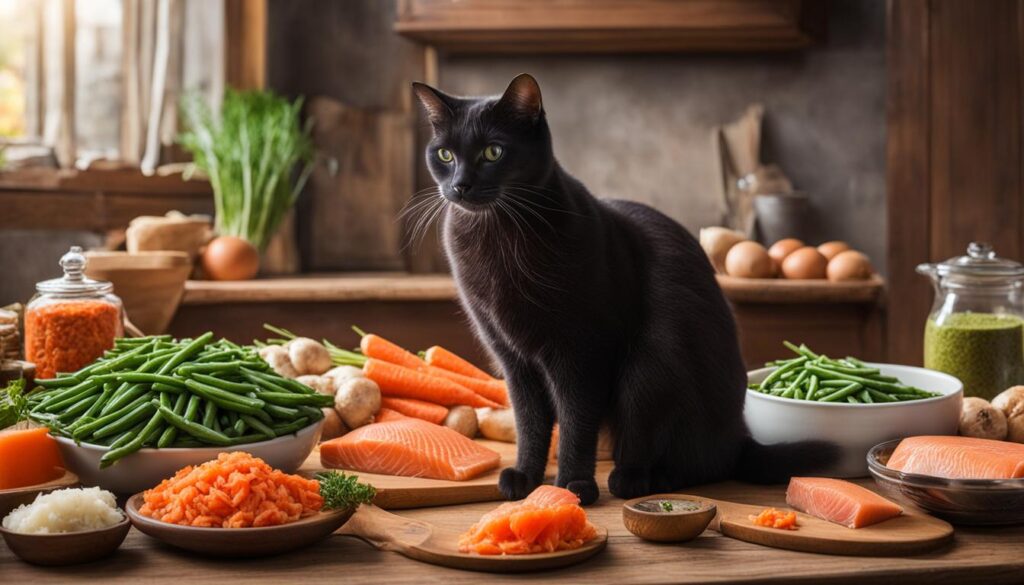
Nutritional Impacts of Human Food on Cats
When cats show interest in human food, it’s important to understand the potential nutritional impacts. While cats may find certain flavors appealing, their dietary needs differ from humans. Feeding cats excessive amounts of human food can lead to nutritional imbalances and health issues.
Cats have specific nutritional requirements that are best met through a balanced cat food diet. Commercial cat foods are formulated to provide the necessary nutrients, vitamins, and minerals that cats need to thrive. Human food should only represent a small percentage of a cat’s daily food intake and should never substitute their regular cat food.
To ensure cats receive the proper nutrition, cat parents should consult with their veterinarian. They can provide valuable guidance on safe human foods for cats and help develop a feeding plan that meets their individual cat’s needs. It’s crucial to avoid feeding cats foods that are toxic to them, such as onions, garlic, chocolate, and caffeine.
| Nutritional Impacts of Human Food on Cats | Safe Human Foods for Cats |
|---|---|
| Can lead to nutritional imbalances | Small pieces of cooked chicken or turkey |
| May cause health issues | Plain cooked fish |
| Does not meet cats’ specific dietary needs | Certain fruits and vegetables |
By prioritizing a nutritionally balanced cat food diet and providing safe human foods in moderation, cat parents can ensure their furry friends remain healthy and satisfied.
Understanding Cat Food Begging Behaviors
Cats have a way of charming their way into our hearts, and sometimes, our dinner plates. It’s not uncommon for our feline friends to exhibit begging behaviors when it comes to human food. But why exactly do cats beg for our food? And what can we do to manage this behavior? Let’s take a closer look at some of the reasons behind their food curiosity.
One of the primary reasons cats are attracted to certain foods is their natural curiosity. Cats are hunters by nature, and their keen sense of smell and taste make them curious about the flavors and aromas we enjoy. They may show interest in our meals simply because they want to explore and understand the world around them.
Furthermore, cats have individual taste preferences, just like humans. Certain flavors and textures may be more appealing to them, which is why they may be particularly drawn to certain human foods. It’s important to remember, however, that cats have unique dietary needs and should primarily be fed a nutritionally balanced cat food. While small amounts of safe human foods can be given as occasional treats, it’s crucial to avoid feeding cats anything that could be harmful to their health.
To manage cat food begging behaviors, it’s essential to set boundaries and reinforce training. Create a safe and consistent feeding routine for your cat to reduce their reliance on human food. Avoid giving in to their begging and provide them with interactive toys and enrichment activities to keep them mentally stimulated. By providing a balanced and satisfying diet and engaging them in play, you can help redirect their curiosity and manage their food-seeking behaviors.
| Reasons Cats Beg for Food | How to Manage Begging Behaviors |
|---|---|
| Curiosity about flavors and aromas | Set boundaries and reinforce training |
| Individual taste preferences | Create a consistent feeding routine |
| Desire to imitate human behavior | Provide interactive toys and enrichment activities |
It’s important to remember that while cats may beg for our food, it’s our responsibility as cat parents to ensure they receive a healthy and balanced diet. By understanding the reasons behind their food curiosity and taking appropriate steps to manage their behavior, we can help our feline friends lead happy and fulfilling lives.
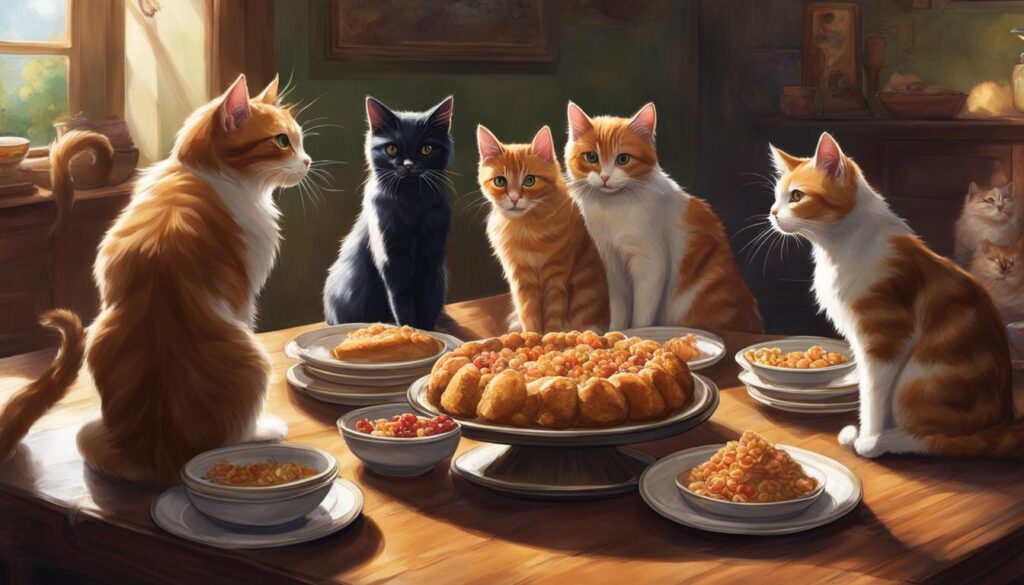
Conclusion
Cats’ interest in human food is a fascinating behavior that stems from their innate curiosity and taste preferences. Understanding why cats are drawn to human food can help us provide them with a balanced diet and prevent them from consuming excessive amounts of it.
While it is crucial to keep cats from eating too much human food, there are safe options that can be given to them in moderation. Consulting with a veterinarian can help identify which human foods are suitable for our feline friends. Offering small pieces of cooked chicken or fish, as well as certain fruits and vegetables, can be a delightful treat for them.
To prevent cats from eating human food, it is important to establish boundaries and reinforce training. Avoid encouraging their interest in our meals, and discourage begging behaviors by focusing on positive reinforcement and interactive play. By doing so, we can satisfy their curiosity while ensuring their nutritional needs are met.
In conclusion, understanding cats’ taste preferences and managing their curiosity about human food are essential for their well-being. By providing a balanced diet, incorporating safe human foods in moderation, and training them to avoid excessive consumption, we can foster a healthy relationship between our cats and food.
FAQ
Why are cats curious about human food?
Cats have a natural curiosity, and they are interested in exploring different smells and tastes, including the food their human family consumes. Additionally, cats have taste preferences and may find certain human foods more appealing than their own cat food.
How can I train my cat to avoid eating human food?
To train your cat to avoid eating human food, you can start by not actively encouraging them to eat it and avoiding using human food as treats. Discouraging begging by ignoring the cat and preventing them from accessing the kitchen counter or dining table can also help. Positive reinforcement, such as rewarding the cat for staying on the floor during mealtimes, can be effective.
Can I give my cat any human food?
There are certain human foods that can be safely given to cats in moderation. However, it is crucial to consult with a veterinarian to determine which human foods are safe for cats. Some examples of safe human foods for cats include small pieces of cooked chicken or turkey, plain cooked fish, and certain fruits and vegetables. It is important to avoid feeding cats foods that are toxic to them, such as onions, garlic, chocolate, and caffeine.
What are the nutritional impacts of feeding cats human food?
Feeding cats excessive amounts of human food can lead to nutritional imbalances and health issues. Cats have different nutritional needs from humans, so it is important to ensure their diet is primarily composed of a nutritionally balanced cat food. Human food should only represent a small percentage of their daily food intake and should not substitute their regular cat food.
Why do cats beg for human food?
Cats may exhibit begging behaviors for human food due to their natural curiosity, desire to imitate their human parents, or preference for certain flavors. Some cats may even attempt to steal food from their human’s hand. Setting boundaries, reinforcing training, and providing a balanced and satisfying diet for cats can help manage their food curiosity and begging behaviors.

